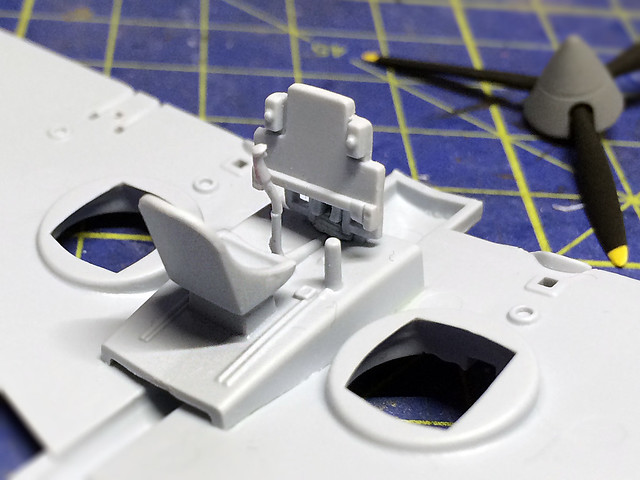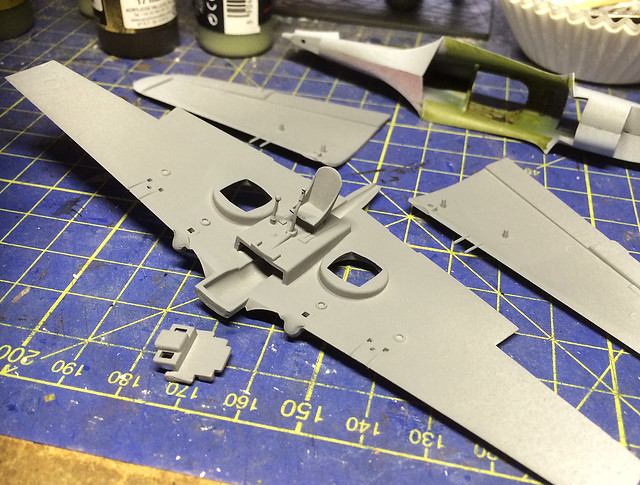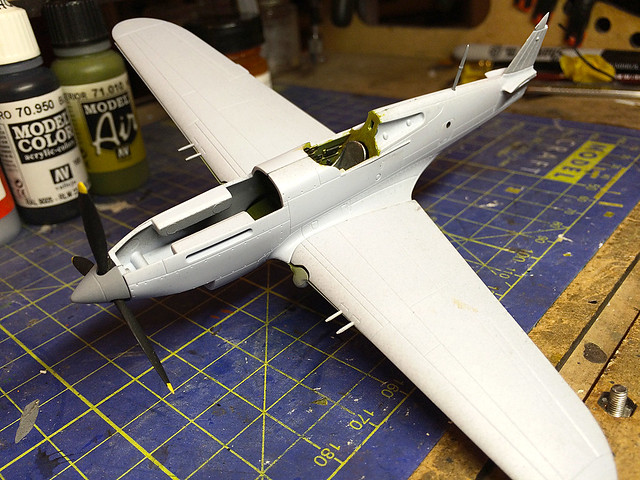Just to re-cap; I got the fuselage glued together and the propeller assembly done. I was in a bit of a quandary about when to attach the prop, Airfix suggest early but I was concerned about how that would complicate painting later on. So I decided to leave the propeller off for the time being.
All of a sudden there is a lot going on with my Airfix Tomahawk IIA as the slow start of my previous post gives way to work on some of the major components. To begin with, though, I put the finishing touches to the cockpit.
 |
No dials? Nope - there is a very nice decal to add to the control panel. Some of the
other elements are a little 'chunky' - check out that thick post to the right of the
pilot's seat. That's the auxiliary hydraulic pump handle, which allows the pilot
to jack up/down the undercarriage in an emergency. It should be a quarter of this
thickness. I will probably replace this. |
The last parts of the cockpit interior are the cabin floor, control panel, pilot’s seat and joystick. As with the rest of the cockpit detail these items are somewhat simplified and ‘chunky’. There are plenty of much finer third party upgrades available if you really want to ‘pimp’ your Tomahawk, but I don’t think the level of detail is all that bad for a part of the plane’s interior which is partially hidden.
But this leads on to the big job of attaching the wings to the fuselage.
 |
| Wing components and cockpit interior primed and ready to paint. |
The big one-piece belly and lower-wing component (which incorporates the inner-cockpit) is a pretty solid piece. I considered this a nice plus point as it means you worry less about a sturdy wing alignment - an aspect of aircraft kits that used to infuriate me when I was a junior model maker (squint wing syndrome).
Test fitting the fuselage to the under-wing did seem to indicate that there would be the inevitable filling to do at the root joints. But it wasn't horrendous, but considering this is a kit aimed at 'beginners' any filling is a bit of an annoyance...
 |
Not major gaps by any means but they do definitely need filling with modeller's putty and then sanding
smooth. A real beginner might not be ready to undertake such a job, even if 'we' think it's minor. |
We are - for the pedantic among you - at panel 6 of the Airfix instructions now. And we are instructed to join the upper wings to the lower and the wing assembly to the fuselage.
Before putting all these pieces together, however, the inner surfaces must be painted. The lower cockpit, pilot's set and control panel and the inside of the wings - which will be seen through the landing gear wells - all need a coat of the 'interior green'. I didn't care for the Hakata RAF Interior Grey-Green colour so I'm now having a go with
Vallejo's Model Air [71.010] Interior Green.
I then shaded the green (using Vallejo's Game Colour Sepia Wash and some yellow artists ink) to give it the distinctive yellowish green that Curtiss used on the P-40's interiors...Or at least I tried. To be honest I'm still unclear whether or not the RAF repainted the Tomahawk's interior or whether they retained the original factory interior colour.
The hardest thing was resisting the temptation to dress up the standard Airfix cockpit by scratch-building this or that part or adding some of the excellent third-party upgrade parts. But I stuck to my guns and built the cockpit 'out the box'. And I don't think it looks too bad, the panel decal is a very nice touch.






Looking a very clean build
ReplyDeleteLike your cock-pit work :)
Nice work on an old Airfix kit